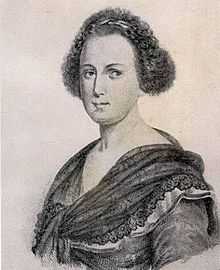Eleonora Fonseca Pimentel

Eleonora Anna Maria Felice de Fonseca Pimentel (born Leonor da Fonseca Pimentel Chaves; 13 January 1752 – 20 August 1799) was an Italian poet and revolutionary connected with the Neapolitan revolution and subsequent short-lived Neapolitan Republic (also known as the Parthenopean Republic) of 1799, a sister republic of the French Republic and one of many set up in the 1790s in Europe.
Biography
Pimentel was born in Rome of Portuguese nobility. She was a precocious child who wrote poetry and read Latin and Greek. As a child, she moved with her family to Naples as a result of political difficulties between the Papal States (of which Rome was the capital) and the Kingdom of Portugal.
In the 1770s she became an important part of literary circles of the day in Naples. Much of her literary output was given over to voluminous exchanges of letters with other literati. Most prominent of these is a long correspondence in the 1770s with Metastasio, the Italian court poet in Vienna and greatest librettist of the 18th century.
In the 1790s she became involved in the Jacobin movement in Naples that was working to overthrow the monarchy and establish a local version of the French Republic. She was one of the leaders of the revolution that overthrew the Bourbon monarchy and installed the Parthenopean Republic in January 1799.
For the short life of that republic, she edited and wrote most of the material for the Monitore Napoletano, the newspaper of the Republic - named in emulation of Le Moniteur Universel in France. When the Republic was overthrown and the Bourbon monarchy restored later that year, she was one of those revolutionaries executed by the sham royal tribunals implemented by Horatio Nelson.
She tried to avert the death penalty by claiming to be pregnant. When she was discovered not to be, she asked at least to be beheaded, not hanged, but there was no mercy. The public hanging of a noblewoman was seen as something quite outrageous. Eleonora Pimentel had not committed any crimes during the revolution. She only edited newspapers and worked as a journalist.
Reportedly, a main reason for the restored monarchy insisting on her execution were pamphlets she wrote denouncing Queen Maria Carolina as a lesbian.[1]
Bibliography
- Benedetto Croce, Eleonora de Fonseca Pimentel, Roma, Tipografia Nazionale, 1887 (Italian)
- Bice Gurgo, Eleonora Fonseca Pimentel, Napoli, Cooperativa Libreria, 1935 (Italian)
- Maria Antonietta Macciocchi, Cara Eleonora, Milano, Rizzoli, 1993 (Italian)
- Elena Urgnani, La Vicenda Letteraria e Politica di Eleonora de Fonseca Pimentel, Napoli, La Città del Sole, 1998 (Italian)
- Enzo Striano, Il resto di niente. Storia di Eleonora de Fonseca Pimentel e della rivoluzione napoletana del 1799, Napoli, Avagliano 1999; Milano, Rizzoli 2001, 2004 (Italian)
- Nico Perrone, La Loggia della Philantropia, Palermo, Sellerio, 2006 ISBN 88-389-2141-5 (Italian)
- Maria Rosaria Pelizzari, Eleonora de Fonseca Pimentel: morire per la rivoluzione, Storia delle Donne 4/2008 - «Correrò questo rischio» Sacrificio, sfida, resistenza (Italian)
Notes
- ↑ Urgnani, p. 103
External links
- This item is an abridged version of an article from an external source and has been placed here by the author and copyright holder of that article.
- Biographie Eleonora Fonseca Pimentel by EPOCHE NAPOLEON (German)
- ZEIT-Artikel von Fried (German)
|